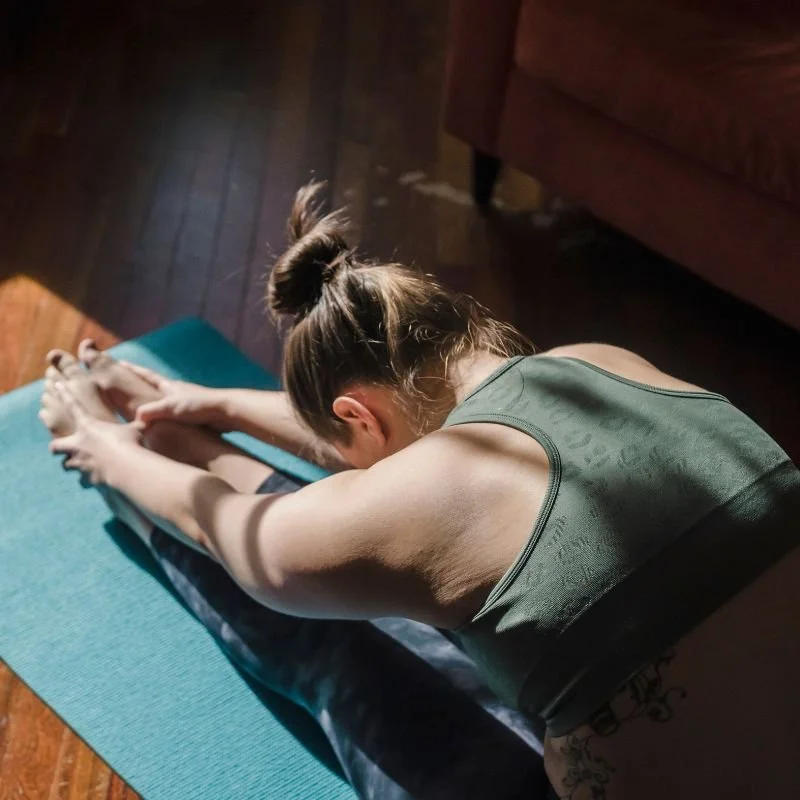This blog post was first sent to Jenni’s email list as an email newsletter. Sign up for the JRY email newsletter here!
When we stretch, do we mainly stretch muscles or tendons?

This is a great yoga geeky question 🤓, and before we dive into the answer, let’s establish some quick anatomical definitions first:
Muscle: a tissue of the body that contracts and relaxes, creating (and preventing) movement
Tendon: a type of connective tissue that transmits force from muscle contractions to bones
When we learn about tendons, we typically learn that they “connect muscles to bones.”
This is certainly true in a sense.
But this definition can sometimes give us the impression that tendons are completely separate tissues from muscles and from bones – as though a muscle somehow “plugs into” a tendon, and the tendon, in turn, is “glued onto” a bone. 🙂
But in reality, our tissues aren’t so separate! They’re actually quite woven together and continuous.
A cooler way to think about the relationship between these tissues is that the connective tissue layers within a muscle continue beyond the muscle and become the tendon, and the tendon becomes the bone.

But let’s get back to the question at hand here: when we stretch, do we mainly stretch muscles or tendons?
The answer to this question is: muscle!
Muscle tissue stretches more easily than tendon tissue does, so when we perform a stretch, the main tissue being stretched is muscle, not tendon.
This is because biomechanically, tendons are a stiffer tissue than muscles are.
When we stretch, both tendons and muscles will stretch to some degree (because they’re continuous), but the less stiff tissue (muscle) will stretch much more.
Why does this matter?
There’s a lot of dialogue in the yoga world these days about the importance of having strong, healthy tendons.
Not only do stronger (stiffer) tendons transmit force and create movement more efficiently, but stronger tendons also reduce one’s risk of developing “yoga butt” (a.k.a. proximal hamstring tendinopathy, or that high hamstring pain that’s semi-common among yoga practitioners).
So strong tendons are a definite plus for yogis!
But… does stretching strengthen tendons? As it turns out, no!

We know from research that tendons adapt to become stronger when they lengthen about 5-6% during training (Lazarczuk et al., 2022).
And as we established earlier, during a stretch, muscle – not tendon – is the main tissue that lengthens. Research suggests that tendons lengthen only about 1% in passive stretches – far below the 5-6% needed for positive adaptations to take place (Abellaneda et al., 2009).
So passive stretches are not an effective means of increasing tendon strength. (Despite the many claims we hear to the contrary in the yoga world!)
But do you know what is an effective means of strengthening tendons? Strength training! 💪
This is because when we strength train, our muscles contract and become much stiffer than they are when we passively stretch.
When our muscles are working hard, they can become so stiff that they physically *pull* tendons to a longer length than they experience in passive stretching.
But! Load matters: “light intensity” strength training doesn’t do the trick.

2- and 5-pound pink dumbbells 🙂 and other forms of “light intensity” strength training are simply not enough load to strengthen tendons. ❌
Current evidence suggests that the best way to adapt tendons is with moderate-to-heavy strength training (Lazarczuk et al., 2022)
This means lifting weights that are at least 70% of your 1-rep max. (Your 1-rep max is the heaviest weight you could lift once.)
Only heavier loads require our muscles to work hard enough to pull the tendons into that all-important 4-6% range of lengthening needed for adaptation!
So where does that leave yogis?
Yoga doesn’t involve enough load to meaningfully strengthen our tendons.
Therefore, if we’re interested in strong tendons (and reducing our risk of developing “yoga butt”), we should strength train outside our yoga practice!
Strength training builds strong tendons, muscles, and bones (!) – all qualities that we miss out on yoga.
And a dedicated strength practice helps create a yoga practice that’s more sustainable and enjoyable in the long term!
Where can yogis who are new to strength training start?
Start building strength with me and Exercise Science professor Travis Pollen, PhD (!) in our one-of-a-kind Strength for Yoga Remote Group Training program!
We designed this program specifically for yogis who are new to strength training.
Learn more and try it out at no cost. Your tendons will thank you! 😃

Start 7-day free trial of RGT!


